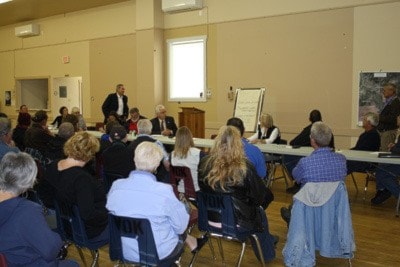Regional district representatives joined village staff and council, BC Fruit Growers Association representative Glen Lucas and Lilly Zekanovic, Constituency Assistant to BC Southern Interior MP Alex Atamanenko at Victory Hall last Wednesday to discuss migratory farmworkers issues.
The government representatives were present along with a contingent of farmworkers in a rare get together of the two groups, witnessed by approximately 30 members of the public.
Discussion centred on four questions, gleaned from a previous discussion that took place on September 23 during a “coffee with the mayor” meeting.
The questions dealt with a proposal for a new campground for the migratory farmworkers, to be located between a half mile and a mile from the flashing light in Cawston.
Questions being posed at last Wednesday’s meeting included:
- what the proposed size of the campgrounds should be.
- what constituted the basic needs of the worker.
- ways to separate and identify legitimate workers from transients.
- how the social standard of the village could be protected.
RDOS Community Services Manager Mark Woods discussed methods other communities had used to resolve the migratory worker problem. He told the assembly that the farming community had to be involved in the process - a group that, noticeably, had little representation at the meeting.
Mayor Despot agreed, commenting that the village only contained 40 acres of farmland and the issue at hand was really one which farmworkers and farmers would have to be involved in for the issue to move forward.
Farmworkers asked about the prospect of additional services being provided, things like laundry and internet access, to which Despot answered that it would be up to the (farming) industry to provide those additional needs.
Only one site in the proximity of the Cawston red light could be identified as suitable, although it was noted that two other possible sites could be looked at as options.
Discussion also concerned the prospect of someone making the campground a commercial private venture, where cash flow could be generated earlier in the season.
One of the farmworkers present stated that the farmers should provide basic necessities at the locations where they worked, a comment that had many present nodding their heads in agreement.
Basic needs were tentatively identified as having running water, toilet and shower facilities and facilities to wash clothes. One farmworker commented that without these facilities, the Lower Similkameen was not attracting the best workers, while another farmworker’s suggestion that they be allowed to use the community pool received an emphatic “no” from many present.
Discussion also involved programs and funding situations made available to the Foreign Agricultural Workers Program. A suggestion that more funding from federal and provincial levels were required was made, along with a suggestion that inspections should be made at individual farms to ensure they had facilities for workers.
“Inspectors go around mainly for the foreign workers program,” explained one member of the audience. “In some cases, when they come out in the spring to inspect a farm, they are shown accommodations that are then switched when the foreign workers arrive. There isn’t enough inspection.”
It was generally agreed by those who had experience, that the migrant worker system in Naramata worked quite well - but it came at a higher economic cost, and the local agricultural community supported the effort.
Area “G” Director Elef Christensen stated that he would not favour putting any more money into the campground effort until the non-worker transient issue was resolved first.
BC Fruit Growers Association representative Glen Lucas agreed that there was a need to separate the two groups, noting that the non-working transients “camouflaged” themselves, and there was a need to “split off the bad actors.”
A farmworker told the gathering that “these people exploited unorganized situations,” while a member of the audience took exception to Director Christensen’s comments, noting that the non - working transients issue was not the fault of the farmworkers.
The third question - how to separate farmworkers from transients - proved to be a difficult one to find a solution to, or direction to pursue without having answers to the other three questions first.
One farmworker stated that they, too, were “part of this community and were trying to make a bridge with it.”
Mayor Despot (who also acted as chairman for the meeting) noted that historically the two groups had been at odds, and it wasn’t a good thing for either group.
“If we are going to attempt to provide these facilities for you,” he said to the farmworkers present, “ we are asking you to accept our social standards.” He described the community’s social demographic, adding, “What has to take place is for this to work both ways.
We don’t want to see shoplifting, drinking in the street, or public indecency. I can’t do it - you shouldn’t be either. You’re our guests here.”
A farmworker replied that the group did not need to be “separated and ghettoized.”
Progress has been slow moving,” commented another farmworker, “Two porta potties on a flood plain is all we have after 30 years.”
“The village is not a big player in this,” answered the mayor. “This is an issue for Areas “B” and “G” and farmers.”
BCFGA rep Lucas noted that the farmers organization had provided money to the campground effort for two years, in addition to hiring someone full time in the Okanagan to provide orientation and safety training to migratory labourers who were new to the area.
